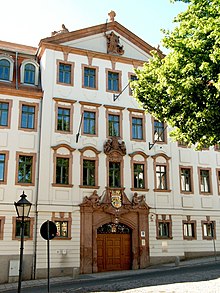Landscape of the Duchy of Saxony-Altenburg

The landscape of the Duchy of Saxony-Altenburg (or Landstands of the Duchy of Saxony-Altenburg or Landtag of the Duchy of Saxony-Altenburg ) was the state parliament of the Duchy of Saxony-Altenburg .
The estates in the old empire
Land estates had existed in Sachsen-Altenburg since ancient times . In 1667, Duke Friedrich Wilhelm II confirmed this land-based order in a state order. This continued to apply until 1831.
Emergence
Article 13 of the federal act stipulated that the member states of the German federal state should enact national constitutions . After the formation of the Duchy of Saxony-Altenburg in 1826, this obligation was initially not fulfilled. The policy of the Restoration in Vormärz ran counter to the early liberal constitutional wishes. On September 14, 1830, Duke Friedrich gave the country the promise of a first Basic Law in the town hall of Altenburg after street fights had broken out in the royal seat under the impact of the July Revolution of 1830 . With a decree of April 29, 1831 Duke Friedrich enacted the Basic Law of the Duchy of Saxony-Altenburg as a constitution . Previously, the old estates had approved the constitution at their last session on January 17, 1831. The landscape was intended to represent the people in Department V (§§ 162 ff.).
1831 until the March Revolution
The landscape consisted of 24 MPs and the landscape president. 8 MPs were directly elected by the manor owners (there were 109 manors eligible for state assembly (1843)) and 8 MPs from the cities (2 for Altenburg, 1 each for Ronneburg, Schmölln, Eisenberg and Roda, 1 for Gößnitz and Meuselwitz and 1 for Kahla and Orlamünde) and 8 of the peasant class were elected in indirect elections.
Its competencies were merely advisory and legislative. He did not have a right of initiative. It should meet every four years.
The landscape president (president of parliament) was appointed by the duke from the representatives of the manor owners.
The first state parliament met on June 11, 1832.
From the March Revolution to Reaction
Under Duke Joseph , a clear opponent of liberal politics, the state parliament was only able to play a secondary role. With the March Revolution , Joseph was forced to resign and a new right to vote for the countryside was decided.
On March 21, 1848, the Landtag (still elected according to the old law) met for the first time in public. So far it had not met publicly. On the same day there was a large popular assembly. This had elected a 12-member citizens' committee, which submitted a draft of a liberal electoral law as a petition to the state parliament. Bernhard August von Lindenau submitted a more restrictive counter-draft to the chamber, but could not prevent the chamber from passing an electoral law with 14 to 9 votes on March 27, 1848, which largely corresponded to the draft of the citizens' committee.
Now the deputies were determined by universal and direct election.
From the Reaction Era to the November Revolution
Liberal suffrage also ended in Saxony-Altenburg with the victory of reaction . In 1850, the electoral law was changed so that the landscape was composed of 9 (directly elected) members of the highest taxed population, 9 members of the cities and 12 members of the rural population. The last two curiae were elected in seven constituencies, each in three classes according to tax performance.
In 1857 the electoral process of 1931 was effectively reintroduced.
The electoral law of May 31, 1870 radically changed the right to vote. The state parliament now consisted of 30 directly elected members: nine members were elected by the urban population, twelve by the rural population and nine by the highest taxed people. Every taxable male citizen who has reached the age of 25 had the right to vote. The deputies were elected for three years.
After the November Revolution of 1918, the mandate of the landscape ended and the state assembly of the Free State of Saxony-Altenburg succeeded it as the legislature .
Courthouse
The state parliament had its seat from 1831 to 1848 in the office and state house in Burgstrasse in Altenburg. The building was erected in 1725 by the baroque master builder Johann Georg Hellbrunn and later used by the local court.
Landscape Presidents
- Bernhard von Lindenau (1831–1848)
- Hans Conon von der Gabelentz (1851–1870)
- Gustav Richard Wagner (1854 and 1870–1879)
MPs
literature
- Wolfgang Enke: The Revolution in Sachsen-Altenburg 1848/49, 2013, ISBN 978-3-86729-121-7
- Basic Law, printed on page 212 ff.
- State and address manual of the Duchy of Saxony-Altenburg, 1838, page 71, online
Web links
- Thuringian State Archives Altenburg
- HGIS (PDF; 36 kB)
Individual evidence
- ↑ The Basic Law of the Duchy of Saxony-Altenburg names all three terms synonymous. The assembly of the estates is usually referred to as the state parliament, the state parliament president as the landscape president
- ↑ A list of goods eligible for the Landtag can be found in the State and Address Manual of the Duchy of Saxony-Altenburg, 1838, pp. 85–95, online